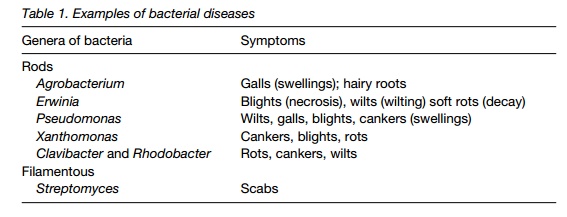Chapter: Plant Biology : Interactions between plants and other organisms
Bacteria, mycoplasma, viruses and heterokonts
BACTERIA, MYCOPLASMA, VIRUSES AND HETEROKONTS
Key Notes
Bacteria
Bacterial diseases include blights, wilts and soft rots. Most plant-infecting bacteria are Gram negative and rod-shaped, except streptomycetes which are filamentous. Some bacteria are beneficial; Rhizobia fix nitrogen and Agrobacteria have been used as the basis for plant genetic engineering.
Mycoplasma
Mycoplasma are bacteria-like organisms, lacking a cell wall, that infect sieve tubes. Commercially damaging phytoplasmas exist for many species.
Viruses
Viruses consist of a protein capsid encasing DNA or RNA and replicate using the host cells. Most plant viruses contain RNA, though a few contain DNA. They are transmitted by a vector. Infection may be limited to one site, or they may travel systemically through plasmodesmata or phloem. Control methods include: meristem tip culture; controlling vectors; and genetic modification to introduce viral capsid genes into plants.
Heterokonts
Heterokonts include oomycetes, which include some important plant pathogens. They produce biflagellate zoospores and resistant oospores that can survive many years in soil before germination. The best known is Phytophthora infestans which causes potato blight.
Bacteria
Bacterial diseases can affect almost any plant and can result in great crop losses. Almost all plant-infecting bacteria are Gram negative and rod-shaped, although members of the genus Streptomyces will infect plants and are filamentous. Some bacteria are beneficial; Rhizobium fixes nitrogen in symbiotic association in root nodules . Agrobacterium, which cause plant galls by inserting bacterial genes into the plant genome, have been used as the basis for plant genetic engineering . The range of diseases caused by other bacteria include:
blights in which necroses, areas of dead tissue, form and spread rapidly through stems, leaves and flowers; wilts in which xylem tissue is destroyed and the plant wilts and dies; and soft rots where fleshy tissue is decayed, particularly in storage tissues. Table 1 gives examples of bacterial diseases.
Mycoplasma
Mycoplasma are bacteria-like organisms lacking a cell wall. Mycoplasma-like organisms that infect plants are known as phytoplasmas and many are commercially important diseases. Carrots, peaches, pears, ornamental flowers and coconuts can all be seriously affected. Phytoplasmas normally infectsieve tubes. They are conveyed from plant to plant by vector organisms, such asaphids, that feed on sieve-tube contents.

Viruses
Viruses are non-cellular structures containing DNA or RNA that use the host’s synthetic capability to replicate. Many of the viral diseases known (of which there are more than 2000) are virtually symptom-less other than marked reductions in yield. Examples include tomato mosaic virus. The virus consists of a coat (capsid) made of protein, encasing DNA or RNA that contains the information for infection and replication of the virus. Most plant viruses contain RNA as their genetic information, though three (the badnaviruses, caulimoviruses and geminiviruses) contain DNA. Viruses are frequently transmitted from plant to plant by a vector organism, e.g. an insect, but seldom infect the vector. Viruses may have a limited site of infection, or may travel systemically through plasmodesmata from cell to cell, or through the phloem. Movement through plasmodesmata involves the synthesis of movement proteins, encoded by the virus, which modify the plasmodesmata. Control methods include: meristemtip culture (using plant tissue culture;) in which plants are propagated from virus-free tissue; developing resistant strains; controlling vectors. Recently, genetic modification has been used to introduce viral capsid genes into some plants, thereby preventing the virus from replicating. Diagnosis of viral disease is often difficult, with few visual symptoms. Viruses can build in plants while old individuals can be weakened by them.
Heterokonts
Heterokonts are eukaryotic organisms with one long and one short flagellum. They include diatoms and algae and the phylum Oomycota, theoomycetes, which include some important plant pathogens. The Oomycota produce biflagellatezoospores, the means of asexual reproduction of the organism, and can also reproduce sexually to produce oospores, which are resistant and can survive many years in soil before germination. Oomycetes form hyphae within infected tissue and are very destructive. Examples are Phytophthora infestans, the potato blight, which reached Europe in the 1840s and spread with devastating consequences of famine and emigration; P. cynamoni, which kills avocado trees; Plasmopara viticola which causesdowny mildew of grape vines and Pythium species which cause damping-off of seedlings.
Related Topics